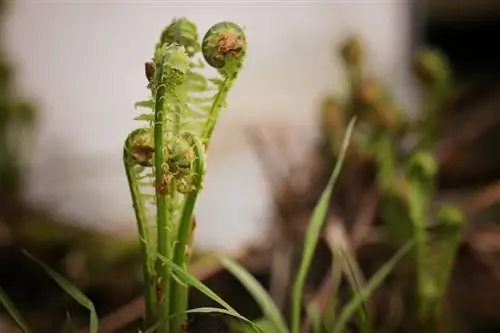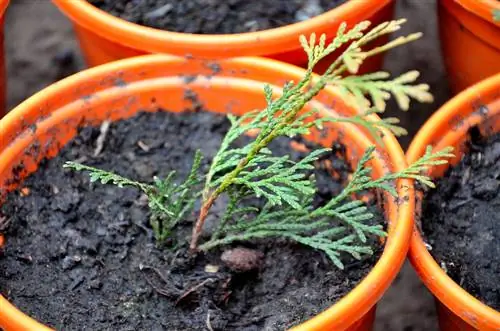- Author admin [email protected].
- Public 2023-12-16 16:46.
- Last modified 2025-01-23 11:21.
Privet is very popular as a robust hedge plant because it can cope well with the city climate. Propagating the shrub from cuttings is very easy and even beginners can do it without any problems. How to grow privet cuttings yourself.

How to grow privet cuttings?
To propagate privet cuttings in spring, choose 20 cm long, non-woody shoots, remove the lower leaves and shorten the top. Place the cuttings in prepared pots or outdoors, water regularly and shorten the shoot by one to two thirds after cutting. Transplanting is possible as soon as new leaves and side shoots appear.
Propagate privet via cuttings
The easiest way to propagate a privet is by taking cuttings. Young shoots that you can use for this are abundant in spring and summer.
Other options for growing privet plants yourself are cuttings and sinkers.
The best time to take cuttings
In spring you usually cut back a privet significantly. Then there will be a lot of leftover cuttings that you can use as cuttings.
The shoots should be 20 cm long if possible and must not be woody at the bottom.
Prepare cuttings correctly
- Cut cutting cleanly
- remove lower leaves
- halve very large leaves
- Cut the tip of the shoot
Use clean and very sharp cutting tools. You can transmit diseases through unclean tools. Blunt cutting edges cause the skins of the privet shoots to tear, providing an opportunity for fungal spores to penetrate the offshoot.
Put privet offshoots in pots or outdoors
You can put privet cuttings in prepared pots. To do this, use slightly deeper planters that you fill with a mixture of garden soil and mature compost. There must be a drainage hole to prevent waterlogging.
You can also place the cuttings directly in the desired location in the garden. The soil must be permeable to water and should first be improved with compost and horn shavings.
Insert the cuttings about five cm deep into the substrate and press the soil firmly so that the cuttings grow straight.
Continue to care for privet cuttings
Short the shoots by approximately one to two thirds after plugging at the latest. Only then can the offshoots branch out well from the start.
Water regularly, but avoid waterlogging.
If the cuttings are outdoors, you should spread a layer of mulch around them. This prevents the soil from drying out and protects the privet offshoots from the first frosts in winter.
When can you transplant cuttings?
You can tell that the cutting has formed roots because it has new leaves and side shoots. You can now take the offshoots out of the pot and transplant them to the desired location.
Rooting usually happens very quickly, so you can often transplant the young plants in the fall.
Propagation of privet through cuttings
Cuttings are caused by severe pruning. They are already woody at the bottom and simply need to be stuck into the ground in the designated place and watered well.
Tip
In the wild, a privet bush can reach a height of up to five meters. In the garden it is rarely grown this high as a hedge.






